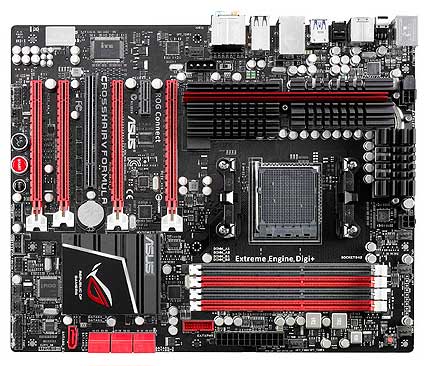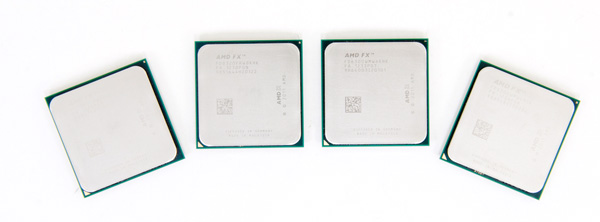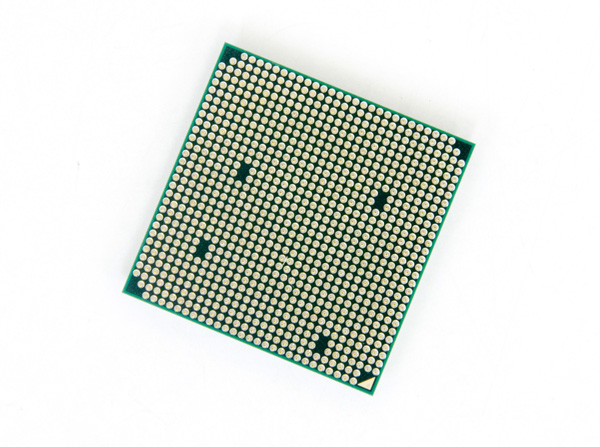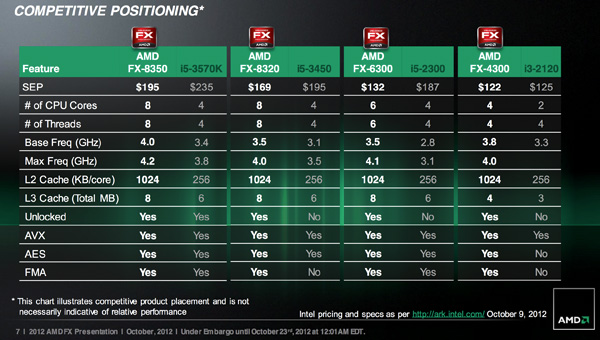The Vishera Review: AMD FX-8350, FX-8320, FX-6300 and FX-4300 Tested
by Anand Lal Shimpi on October 23, 2012 12:00 AM ESTLast year's launch of AMD's FX processors was honestly disappointing. The Bulldozer CPU cores that were bundled into each Zambezi chip were hardly power efficient and in many areas couldn't significantly outperform AMD's previous generation platform. Look beyond the direct AMD comparison and the situation looked even worse. In our conclusion to last year's FX-8150 review I wrote the following:
"Single threaded performance is my biggest concern, and compared to Sandy Bridge there's a good 40-50% advantage the i5 2500K enjoys over the FX-8150. My hope is that future derivatives of the FX processor (perhaps based on Piledriver) will boast much more aggressive Turbo Core frequencies, which would do wonders at eating into that advantage."
The performance advantage that Intel enjoyed at the time was beyond what could be erased by a single generation. To make matters worse, before AMD could rev Bulldozer, Intel already began shipping Ivy Bridge - a part that not only increased performance but decreased power consumption as well. It's been a rough road for AMD over these past few years, but you have to give credit where it's due: we haven't seen AMD executing this consistently in quite a while. As promised we've now had multiple generations of each platform ship from AMD. Brazos had a mild update, Llano paved the way for Trinity which is now shipping, and around a year after Zambezi's launch we have Vishera: the Piledriver based AMD FX successor.
At a high level, Vishera swaps out the Bulldozer cores from Zambezi and replaces them with Piledriver. This is the same CPU core that is used in Trinity, but it's optimized for a very different purpose here in Vishera. While Trinity had to worry about working nicely in a laptop, Vishera is strictly a high-end desktop/workstation part. There's no on-die graphics for starters. Clock speeds and TDPs are also up compared to Trinity.
| CPU Specification Comparison | ||||||||
| CPU | Manufacturing Process | Cores | Transistor Count | Die Size | ||||
| AMD Vishera 8C | 32nm | 8 | 1.2B | 315mm2 | ||||
| AMD Zambezi 8C | 32nm | 8 | 1.2B | 315mm2 | ||||
| Intel Ivy Bridge 4C | 22nm | 4 | 1.4B | 160mm2 | ||||
| Intel Sandy Bridge E (6C) | 32nm | 6 | 2.27B | 435mm2 | ||||
| Intel Sandy Bridge E (4C) | 32nm | 4 | 1.27B | 294mm2 | ||||
| Intel Sandy Bridge 4C | 32nm | 4 | 1.16B | 216mm2 | ||||
| Intel Lynnfield 4C | 45nm | 4 | 774M | 296mm2 | ||||
| Intel Sandy Bridge 2C (GT1) | 32nm | 2 | 504M | 131mm2 | ||||
| Intel Sandy Bridge 2C (GT2) | 32nm | 2 | 624M | 149mm2 | ||||
Vishera is still built on the same 32nm GlobalFoundries SOI process as Zambezi, which means there isn't much room for additional architectural complexity without ballooning die area, and not a whole lot of hope for significantly decreasing power consumption. As a fabless semiconductor manufacturer, AMD is now at GF's mercy when it comes to moving process technology forward. It simply has to make 32nm work for now. Piledriver is a light evolution over Bulldozer, so there's actually no substantial increase in die area compared to the previous generation. Cache sizes remain the same as well, which keeps everything roughly the same. These chips are obviously much larger than Intel's 22nm Ivy Bridge parts, but Intel has a full node advantage there which enables that.
Piledriver is a bit more power efficient than Bulldozer, which enables AMD to drive Vishera's frequency up while remaining in the same thermal envelope as Zambezi. The new lineup is in the table below:
| CPU Specification Comparison | ||||||||||
| Processor | Codename | Cores | Clock Speed | Max Turbo | L2/L3 Cache | TDP | Price | |||
| AMD FX-8350 | Vishera | 8 | 4.0GHz | 4.2GHz | 8MB/8MB | 125W | $199 | |||
| AMD FX-8150 | Zambezi | 8 | 3.6GHz | 4.2GHz | 8MB/8MB | 125W | $183 | |||
| AMD FX-8320 | Vishera | 8 | 3.5GHz | 4.0GHz | 8MB/8MB | 125W | $169 | |||
| AMD FX-8120 | Zambezi | 8 | 3.1GHz | 4.0GHz | 8MB/8MB | 125W | $153 | |||
| AMD FX-6300 | Vishera | 6 | 3.5GHz | 4.1GHz | 6MB/8MB | 95W | $132 | |||
| AMD FX-6100 | Zambezi | 6 | 3.3GHz | 3.9GHz | 6MB/8MB | 95W | $112 | |||
| AMD FX-4300 | Vishera | 4 | 3.8GHz | 4.0GHz | 4MB/4MB | 95W | $122 | |||
| AMD FX-4100 | Zambezi | 4 | 3.6GHz | 3.8GHz | 4MB/4MB | 95W | $101 | |||
The table above says it all. TDPs haven't changed, cache sizes haven't changed and neither have core counts. Across the board Vishera ships at higher base frequencies than the equivalent Zambezi part, but without increasing max turbo frequency (in the case of the 8-core parts). The 6 and 4 core versions get boosts to both sides, without increasing TDP. In our Trinity notebook review I called the new CPU core Bulldozed Tuned. The table above supports that characterization.
It's also important to note that AMD's pricing this time around is far more sensible. While the FX-8150 debuted at $245, the 8350 drops that price to $199 putting it around $40 less than the Core i5 3570K. The chart below shows where AMD expects all of these CPUs to do battle:
AMD's targets are similar to what they were last time: Intel's Core i5 and below. All of the FX processors remain unlocked and ship fully featured with hardware AES acceleration enabled. Most Socket-AM3+ motherboards on the market today should support the new parts with nothing more than a BIOS update. In fact, I used the same ASUS Crosshair V Formula motherboard I used last year (with a much newer BIOS) for today's review:

The Test
For more comparisons be sure to check out our performance database: Bench.
| Motherboard: | ASUS Maximus V Gene (Intel Z77) ASUS Crosshair V Formula (AMD 990FX) |
| Hard Disk: | Intel X25-M SSD (80GB) Crucial RealSSD C300 OCZ Agility 3 (240GB) Samsung SSD 830 (512GB) |
| Memory: | 4 x 4GB G.Skill Ripjaws X DDR3-1600 9-9-9-20 |
| Video Card: | ATI Radeon HD 5870 (Windows 7) NVIDIA GeForce GTX 680 (Windows 8) |
| Desktop Resolution: | 1920 x 1200 |
| OS: | Windows 7 x64/Windows 8 Pro x64 |













250 Comments
View All Comments
CeriseCogburn - Tuesday, October 30, 2012 - link
Except we can probably agree amd will fail to meet their goal in most of these future cases and fail to meet it and be very late as well (cpu side after all and they suck at being on time) , so some sideways review with all the possible advantages in testing and text will need to be skewed toward the amd side ( and they will be) to be able to claim "amd met it's goal! "Let's face it, if amd meets some bare minimum "test" for "achieving that goal" in one single area, the review will claim "they accomplished it". Like the recent time amd released whatever it was a cpu or a vid card and they had a single or so instance of 5 or 10 PROMISED on the egg shelf the day of their declared release and we were told (yes here) "they did it !"
LOL
On the other side of the "perfectly legitimate 15% is an equal and fair equation of the future", we have Intel, that likely won't be late, and if so just barely, and has the cahunas and record to probably exceed their stated goals.
To be honest, the best I can do for amd is say I like their new cpu name " Steamroller !"
For some reason, and this is of course pure speculation, hopeful ESP, wimmin's intuition, or perhaps a desperate attempt to give them a break...but...
I think the name Steamroller indicates they will have a winner when that puppy comes out.
Yes, I think it's crazy as well, but what if I'm right ?
LOL
I might be absolutely correct.
ac2 - Monday, October 22, 2012 - link
I really like those graphs...Especially the Sysmark and Compile ones, which project Steamroller being ahead of Ivy Bridge, and of course clear wins for the multi-threaded ones.
I wish Anand had done a similar current->projection graph for power consumption as well, that would have been very useful.
* Fingers crossed *, I think (wish!) the next gen APUs, Steamroller + GCN + new process node will be a real winner for AMD assuming power envelop comes down to < 100W TDP across the board and delivery in 2013.
CeriseCogburn - Tuesday, October 30, 2012 - link
Isn't it interesting how when it comes to AMD, the fanboy will go to great lengths never before seen, never before done for any other product from any other entity ever, and I mean ever, and spend their time in pure speculation about the future, graph it out, get their hopes going, take a look at the futureville landscape - LOLIt's AMAZING.
Penti - Tuesday, October 23, 2012 - link
Just proves, as it would that there shouldn't be any AM3+ socket for AMD as there are no high-end processors and it doesn't even help for general computing, workstation and gaming performance that AM3+ has 8-core chips. If you want i3 performance and gaming why would you buy anything over FX4300? If you buy a chip like that why couldn't you and AMD just have gone with FM2 instead? Why not launch 8-core FM2 chips if you really want them in consumers hands? FM2 will get Steamroller, why not make sure it will be thriving as a platform instead of having two desktop platforms? I don't think AM3+ justifies it's existence, I don't really want it and it doesn't really bring anything. It just reminds me of the AM2/+ and AM3 Phenom II days and look dated. I understand that there is no hypertransport in the FM2 platform, but let workstation users just buy Opteron server chips. AMD still needs to up it's singlethreaded performance with about 50%.Mysteoa - Tuesday, October 23, 2012 - link
It is not so easy to make it for FM2. First they have to put the NB inside the CPU in the FX line, for it to work on FM2. That will require more space, power consummation and heat.Penti - Tuesday, October 23, 2012 - link
The NB has been inside the CPU since K8 (Athlon 64 / Opteron 2003). It's only a HT (or IO) to PCIe bridge and integrated GPU in Trinity, and they already have Piledriver in Trinity (only CPU for FM2) so what the hell are you talking about? It performs just the same and are more modern core for core. NB is just DRAM-controller and some registers. I see it more like LGA1155 is good enough for everything now days, so is FM2 despite not having 6 or 8 core CPUs, just having faster cpus is enough. You can bake, bind or layout faster processors for FM2 even adding the number of cores if you like. AM3+ chipset doesn't have PCIe 3.0 in the 990-series and don't seem to be getting it any time soon so why buy into that platform? Certainly isn't much more performing.Enthusiasts can use SR5670 and Opteron's. It's not like 990-series has USB3 support any way. Now, FM2 doesn't have PCIe 3 support either, but might support it in an upgrade. Which of course would require new CPU and new motherboards. On AM3+ it would require new motherboards with new chipset only. Don't think PCIe "2.1" is a hindrance though, and a new CPU would benefit greatly either way. It's just a list of things that adds on the "feels old" category.
ET - Tuesday, October 23, 2012 - link
So you want to block the upgrade path? If as you say the FX4300 is all that people need, they should go ahead and buy Trinity. I'm sure that AMD will also release Athlon CPU's for FM2 like they did with FM1 and Llano. But for people who want a higher end AMD CPU, perhaps to upgrade their old one, being able to use the same socket as the old one did is helpful. A stable platform is a good thing, and AM3+ motherboards have been on the market for a while. I just don't see the rationale behind junking it in favour of the socket-du-jour.Penti - Tuesday, October 23, 2012 - link
Naw, I would say just go with Socket C32 and Opteron derived products. It's an under utilized Socket any way. I don't want to give away choice, just have a more clean and sensible line for desktop. AM3+ just seems like an orphaned platform to put Bulldozer out there. So it has lost it's relevance. They should release higher-performing Trinity chips too is what I would argue for of course. Having four Sockets here doesn't make a lot of sense. Moving to C32 would enable enthusiast like board, cheaper workstation-boards with dual-socket too, i.e. two 8-core 4 module Piledriver chips. It has dual-channel DDR3 like the desktop platform's. Maybe even two higher clocked native 6-core variants would have been something. But they won't do it. Of course Intel doesn't need to counter with an enthusiast platform either.Mainstream platforms is where it's at. Having an upgrade path for two desktop platform's, different chipset's etc doesn't make a lot of sense right now.
SonicIce - Tuesday, October 23, 2012 - link
2nd paragraph: "Look beyond those specific applications however and Intel can pull away with a significantly lead."Dadofamunky - Tuesday, October 23, 2012 - link
With 16GB of RAM and eight threads, why aren't we seeing realistic VM-driven virtualization benchmarks? Honestly, this is a huge application area that remains ignored by AT in their core architecture reviews. Something I always look for and never find.